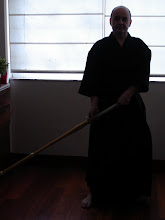Como estoy perezoso os dejo et texto original en inglés. Otro día con más calma lo traduzco.
Pain is inevitable in kendo one way or another, but injuries are preventable. We can learn to endure pain, but it is even more important to learn avoid injuries.
The Achilles tendon allows you to extend your foot, stand on the tip of your toes, and in kendo to launch forward. The recovery from a kendo achilles injury is lengthy and many times kenshi don’t come back the same from one. People who have problems with their feet (like flat feet) are more at risk to suffer an Achilles tendon injury, but the most common reasons of kendo achilles injuries are: overuse, and abrupt increased of training or physical activity.
Identification
Prevention
Prevention
Achilles tendon injuries could come at any time and without warning, some people do experience tightness in the leg muscles and/or tendons prior an injury. Someone can suffer two types of Achilles tendon injuries, tendinitis or rupture (ruptures could be a partial or complete tear, with a complete tear there will be difficulty pointing your toes or extending the foot). Once injured you may experience pain along the back of your foot and above your heel. With tendinitis, pain may be mild and worsen gradually. With achilles rupture, pain can be abrupt and severe.
Cut down on uphill and/or sand running.
Wear ankle support or compression targeted for the tendon.
Increase the intensity of your physical activity slowly.
Stop exercising if you feel pain and tightness in the area.
Please if you feel that you are at risk or think may have an injury, see your healthcare provider.
There are a couple of things you can do to give support to different parts of your body including your achilles tendon. The two most popular are compression gear (click here to check our post on compression gear), and KT tape. (click here to learn more)
Here is a video on how to tape your heel to give support to the achilles tendon.




No hay comentarios:
Publicar un comentario